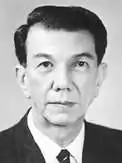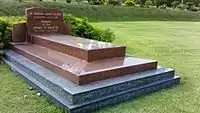Benjamin Sheares
Benjamin Henry Sheares (12 August 1907 – 12 May 1981) was a Singaporean politician who was the second President of Singapore & the commander-in-chief of the Singapore Armed Forces serving a ten-year term from 2 January 1971 to 12 May 1981.
Benjamin Sheares | |
|---|---|
本傑明·亨利·薛爾思 | |
 | |
| 2nd President of Singapore | |
| In office 2 January 1971 – 12 May 1981 | |
| Prime Minister | Lee Kuan Yew |
| Preceded by | Yusof Ishak |
| Succeeded by | Devan Nair |
| Personal details | |
| Born | Benjamin Henry Sheares 12 August 1907 Singapore, Straits Settlements |
| Died | 12 May 1981 (aged 73) Singapore |
| Cause of death | Lung tumour |
| Resting place | Kranji State Cemetery |
| Nationality | Singaporean |
| Political party | Independent |
| Spouse(s) | Yeo Seh Geok Sheares (m.1939–1981)[1] |
| Children | Constance Edwin Chin-Hwee Joseph |
| Alma mater | King Edward VII College of Medicine |
| Occupation | Politician, physician |
| Military service | |
| Commands | Commander-in-Chief of the Singapore Armed Forces |
Sheares retired in 1960 and was in private practice before being elected by parliament as president after President Yusof Ishak died on 23 November 1970.[2] Sheares was sworn in as president on 2 January 1971. He originally wanted to retire after finishing his second term as he felt that he did not have the energy for another term, but then Prime Minister of Singapore, Lee Kuan Yew persuaded him and Sheares took on his third term as president. He served as president for three terms from 2 January 1971 until his death on 12 May 1981.[3]
The Benjamin Sheares Bridge and Sheares Hall hostel at the National University of Singapore was named after him.[4]
Early life and medical career
Benjamin Sheares was born the second of six children in Singapore to a Eurasian family with an English lineage. His father Edwin H. Sheares, a technical supervisor of the Public Works Department, was born in England and raised in India. Edwin later migrated to Penang and married Singapore-born Lilian Gómez, of Chinese Singaporean and Spanish descent, and had six children – the first died in infancy. Life was hard for the Sheares family with the meagre salary that Edwin received from his post.[5]
As a young child, Sheares was affectionately known as Ben or Bennie. He was a quiet boy who kept much to himself and loved to play at Peirce Reservoir, where his father worked.[6]
He had a close relationship with his sister Alice and often loved to play doctor with her. On one occasion, he made Alice swallow a one-cent coin as a medical "pill" in their game. Benjamin was six years old then and received a good hiding from his mother Lilian. Throughout his growing years, Benjamin showed ambition to become a doctor – a dream deemed almost impossible for someone who was Asian and came from a poor family in the early colonial days of Singapore. However, Alice continued to spirit him on with that dream, against his mother's wishes for her son to take up a job as a clerk and start helping out with the family bills as soon as he completed his Senior Cambridge Examinations (O-Level equivalent).[5]
King Edward VII College of Medicine and Royal Postgraduate Medical School
Sheares attended the Hwa Chong Institution and then in 1918 went to Saint Andrew's School, Singapore. In 1922, he transferred himself to study at the Raffles Institution, the only school equipped with scientific laboratories – making it an ideal place to further his ambition to become a doctor. In 1923, he enrolled into the King Edward VII College of Medicine (a predecessor of the National University of Singapore) to begin his medical training.[7] Sheares was aware that his family could not see him through the hefty school fees afforded by the College, therefore he won a generous scholarship offered by the Council of the Medical College with his exemplary academic performance. With this quantum, he was able to give $50 monthly to his mother for the support of his family.
He continued to excel in his studies and was awarded four medals by his college. Later, he passed his Obstetrics and Gynaecology (O&G) final examinations with distinctions. Upon graduation and working as an obstetrician in the Kandang Kerbau Hospital and a professor at the University of Malaya[8] Indonesia he continued to support his family, and assumed full responsibility for his family when his father died in 1940.[5] Sheares was awarded the Queen's Fellowship which would grant him a two-year postgraduate training in Britain. However, his studies were postponed due to the Second World War. During the war in 1941, the hospital Sheares was working at was damaged by the bombing from the Japanese military and it was converted into a general hospital for injured civilians.[9]
After the war, Sheares was appointed acting professor of O&G at the hospital, which he held on until he went for his postgraduate studies at the Royal Postgraduate Medical School in 1947. He returned to Singapore in 1948 and returned to his post as acting professor of O&G at Kandang Kerbau Hospital before he became a full professor in 1950. Sheares then retired from the hospital in 1960 and went into private practice until he was elected president.[9] He became Honorary Consultant after his retirement and continued teaching both undergraduate and postgraduate students at the hospital.[10]
Presidency (1971–1981)
Benjamin Sheares became Singapore's second president on 2 January 1971. His mother was 91 years of age when she learnt that he had become President of the Republic of Singapore. Just two weeks before she died, she said "God has blessed Bennie especially after the way he looked after us and me."[5] According to a medical assistant of his, Sheares had possibly donated his entire salary as President to charity.[11]
Sheares had served three terms as president from 2 January 1971 until 12 May 1981. He originally wanted to retire after finishing his second term as he felt that he did not have the energy for another term, but then Prime Minister Lee Kuan Yew persuaded him and Sheares aged 70 then, took on his third term as president.[12][5] Sheares held the office until his death in 1981.[13][5] C. V. Devan Nair succeeded him as President.
Notable contributions
During his time as head of O&G at Kandang Kerbau Hospital during the Japanese Occupation, Sheares pioneered the lower Caesarian section which resulted in a lower mortality and morbidity rate in pregnant women than the upper Caesarian section. The method is currently the most common Caesarian section method used today.[12] Another one of Sheares' main contributions to medicine was a technique to create an artificial vagina for those born without one. A modification of it is still used for sex change operations today.[14]
Death and legacy

Sheares was found to have tumors in his lung in November 1980 while serving his third term as president. He slipped into a coma on 3 May 1981 and died nine days later on 12th of that month. He was buried at Kranji State Cemetery. The Benjamin Sheares Bridge, Sheares Avenue and Sheares Link are named after him.[15] In academia, the student's residence Sheares Hall in the National University of Singapore, The Benjamin Henry Sheares Professorship in Obstetrics & Gynaecology,[16] The Benjamin Sheares Professorship in Academic Medicine,[17] and the Benjamin Sheares College at the Duke-NUS Graduate Medical School[18][19] are all named after him.
References
- "Remembering Mrs Benjamin Sheares". Duke-NUS. Archived from the original on 9 January 2015. Retrieved 9 January 2015.
- Singapore. Parliament. Parliamentary Debates: Official Report. (30 December 1970). Election of President of Republic of Singapore (Vol. 30, cols. 378–382); Election of President today. (30 December 1970). The Straits Times, p. 6. Retrieved from NewspaperSG.
- Sheares in a coma. (11 May 1981). The Straits Times, p. 1; Lee, P., Ngoo, I., & Bala, K. (13 May 1981). Singapore mourns. The Straits Times, p. 1. Retrieved from NewspaperSG.
- "How they came to be named". The Straits Times, Retrieved from Newspaper SG. 16 August 1994.
- Sheares, J. (Joseph) H.H. (July 2005). "Benjamin Henry Sheares, MD, MS, FRCOG: President, Republic of Singapore 1971–1981; Obstetrician and Gynaecologist 1931–1981 : A Biography, 12th August 1907 – 12th May 1981" (PDF). Annals of the Academy of Medicine, Singapore. 34 (6): 25C–41C. ISSN 0304-4602. Archived from the original (PDF) on 9 February 2006.
- Kaur, R. (1987). The life of Benjamin Henry Sheares 1907–1981 (Thesis). Singapore: Department of History, National University of Singapore. OCLC 962739925.
- "Dr Benjamin Sheares". President's Office. Retrieved 9 January 2015.
- "Benjamin Sheares College". Archived from the original on 30 August 2011. Retrieved 9 January 2015.
- Chia, P. (27 December 1970). Sheares to be president. The Straits Times, p. 1 Retrieved from NewspaperSG; National Library Board. (2004)
- "Dr Benjamin Sheares". Istana Singapore. Retrieved 4 April 2016.
- Dr Chew Shing Chai (10 August 2011). "Good Presidents past". The Straits Times. Archived from the original on 17 August 2011. Retrieved 19 September 2017.
- "A Quiet Determination" (PDF). Eurasians Singapore. June 2011.
- Arunasalam, Sitragandi. "Benjamin Sheares". Singapore Infopedia, National Library Board. Retrieved 9 January 2015.
- Gwee, Elizabeth (20 November 2002). "A long overdue book on KKH". The Straits Times.
- "Benjamin Sheares Bridge". streetdirectory.com. Retrieved 9 January 2015.
- "Continuing the medical legacy of Prof Benjamin Sheares". singhealth.com.sg. Retrieved 4 June 2020.
- "Professor Soo Khee Chee named Benjamin Sheares Professor of Academic Medicine". Duke-NUS. Archived from the original on 9 January 2015. Retrieved 9 January 2015.
- "Duke-NUS Medical School names its advisory colleges". NUS Press Release. Archived from the original on 23 August 2011. Retrieved 1 April 2011.
- "Duke-NUS Sheares College". Archived from the original on 30 August 2011.
Bibliography
- Sheares, J. (Joseph) H.H. (July 2005). "Benjamin Henry Sheares, MD, MS, FRCOG: President, Republic of Singapore 1971–1981; Obstetrician and Gynaecologist 1931–1981: A Biography, 12th August 1907 – 12th May 1981" (PDF). Annals of the Academy of Medicine, Singapore. 34 (6): 25C–41C. ISSN 0304-4602. Archived from the original (PDF) on 9 February 2006.
- "Benjamin Sheares". Istana Singapore: Office of the President of the Republic of Singapore, Government of Singapore. 15 June 2006. Archived from the original on 23 August 2007. Retrieved 24 September 2007.
- Cornelius-Takahama, Vernon (10 November 1997). "Benjamin Sheares Bridge". Singapore Infopedia, National Library Board. Archived from the original on 30 September 2007. Retrieved 23 September 2007.
- Tan, K.H.; Tay, E.H. (2003). "The O&G Fraternity & Pioneers – Professor Benjamin Henry Sheares". The History of Obstetrics & Gynaecology in Singapore. Singapore: Obstetrical and Gynaecological Society of Singapore; National Heritage Board. pp. 412–461. ISBN 978-981-4045-68-1.
| Political offices | ||
|---|---|---|
| Preceded by Yeoh Ghim Seng (acting) |
President of Singapore 1970–1981 |
Succeeded by C.V. Devan Nair |